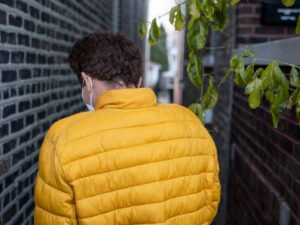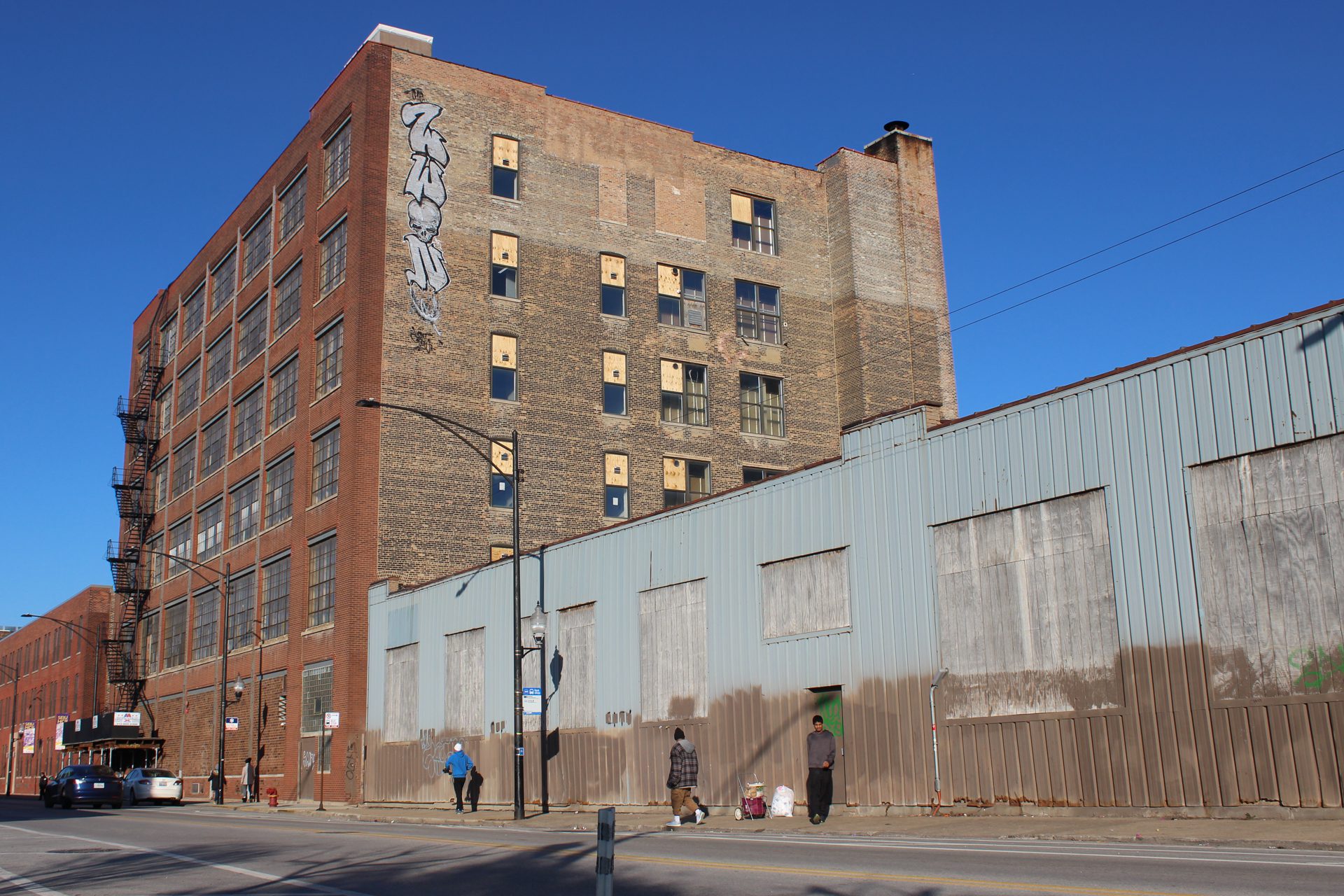 Mauricio Peña/Borderless Magazine
Mauricio Peña/Borderless MagazineJust days after Illinois Gov. Pritzker shut down a proposed shelter due to health concerns, Venezuelan migrants living in the Pilsen shelter say they are being treated “like dogs.’’
Maria* feels the dust and fiber-like particles fall from the ceiling and blanket on her family every time she tries to sleep on her emergency cot nestled among hundreds of other Venezuelan migrants.
It’s cold on most nights. If there’s a heating system in the building, she doesn’t feel it.
Want to receive stories like this in your inbox every week?
Sign up for our free newsletter.

Maria arrived at the former warehouse turned migrant shelter in Chicago’s Pilsen neighborhood about two months ago. In all, it’s been a dehumanizing experience. From frigid temperatures to dirty bathrooms and sometimes spoiled food, the living conditions have been horrible, she said.
“You can’t have anything here,” Maria said. “Nothing. No privacy.“
From the outside, the six-story brick building and its adjoining one-story wood-paneled building look like many other properties in Pilsen’s industrial corridor — rundown, with some windows boarded up and the facade haphazardly painted to cover graffiti. Few exiting the nearby I-90 on their way to shop in Chinatown or eat in Pilsen would guess that the former manufacturing building is now home to the city’s largest migrant shelter. More than 2,300 recently-arrived migrants — all families, some with babies and young children — now call the former manufacturing buildings home, according to an internal city memo obtained by Borderless.
The Pilsen site, which spans half a city block between Cermak Road and the southern branch of the Chicago River, was opened this fall during the city’s scramble to get migrants out of police stations amid dropping temperatures. However, interviews with those living at the shelter and videos Borderless reviewed of conditions inside the building show that the result of that scramble is a building that fails to meet the basic standards for emergency shelter laid out by the U.N. Refugee Agency.
More than a dozen migrants shared their experience with Borderless on the condition of anonymity for fear of being reprimanded and kicked out of the Pilsen shelter. They lamented the harsh shelter conditions, including cramped living quarters, mistreatment from workers, freezing temperatures, and unsanitary bathrooms. Mayor Brandon Johnson’s administration did not respond to questions from Borderless Magazine.
In recent weeks, migrants described outbreaks of various illnesses, including chickenpox, the flu, and upper respiratory infections, spreading without sufficient medical attention. The experiences of migrants inside the Pilsen shelter offer a glimpse inside the city’s network of emergency shelters hurriedly opened to house the migrants being steadily sent to Chicago from the border since August 2022.
For migrants at the shelter like Maria, there are a few options.
“We are thankful for the roof over our heads because we just got here, but I would like to see things like the food get better,” Maria said.
Chicago Officials Scramble to House Migrants
City officials have struggled to house thousands of migrants bused in from Texas and other border states over the last 15 months. Some 29,900 migrants have arrived by bus or plane since August 2022, according to the city’s public dashboard.
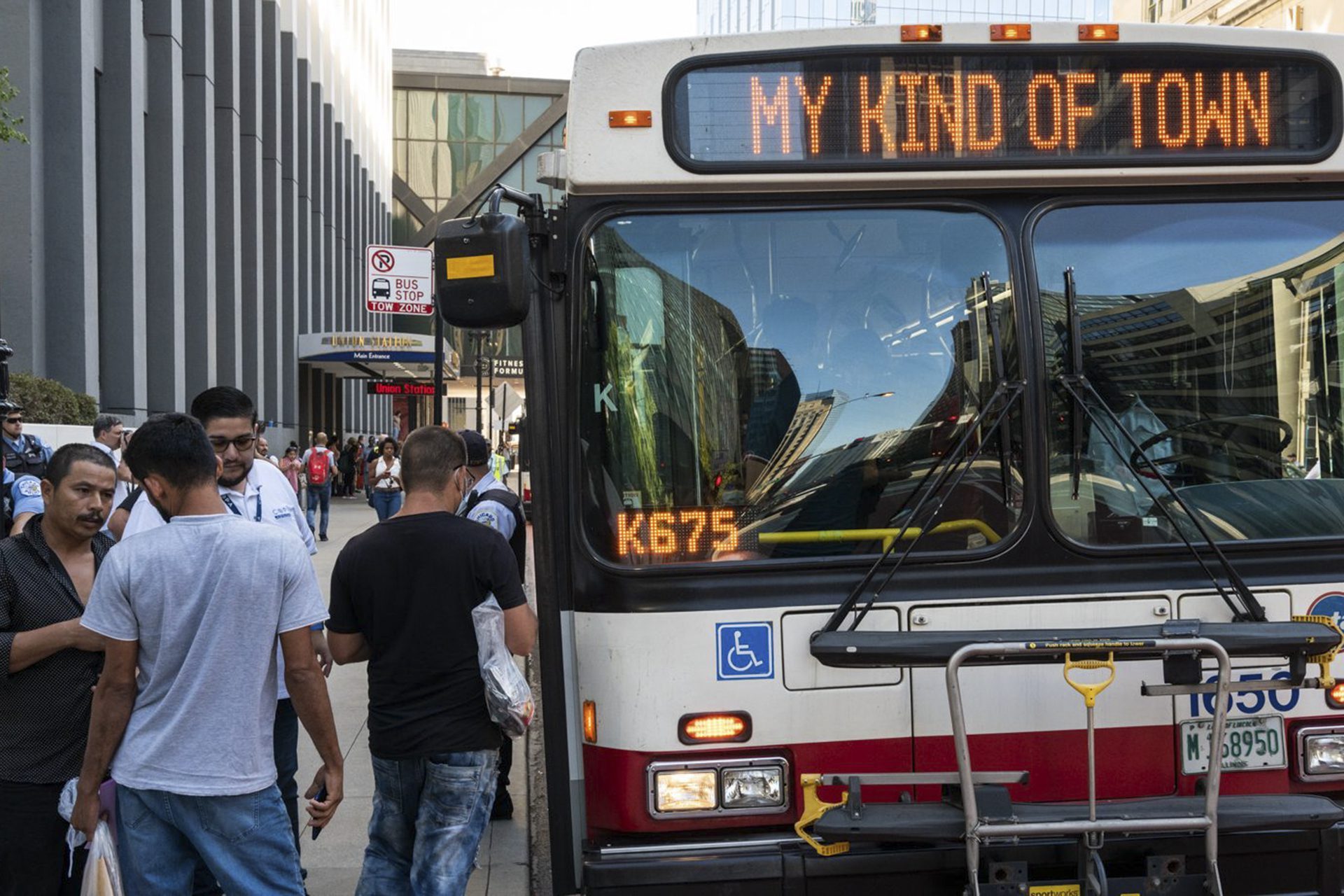
About 13,777 migrants are living across the city’s shelter network, while another 575 are outside of police stations or at O’Hare International Airport as of Dec. 13, according to city data.
Mayor Johnson has doubled down on the city’s commitment to migrant resettlement efforts, saying in a press release the city was treating “new neighbors with compassion because it was the humane thing to do and because with support, they can become productive members of our communities, contributing to our economy, our culture and our society.”
But Johnson’s decision in late November to shorten shelter stays to 60 days has been widely criticized by immigrant advocates who called the change “unreasonable” and charged that the rule would create instability for migrants. Most newly arrived migrants cannot work legally and thus cannot rent an apartment, a reality that advocates say will lead migrants to become homeless during the colder months when they are forced out of city shelters.
Johnson has faced further scrutiny over a controversial tent city in Chicago’s Brighton Park neighborhood that was to be run by GardaWorld. The security firm’s previous projects include an El Paso detention facility for unaccompanied migrant children that was found to have “gross mismanagement,” with allegations of unsafe and unsanitary conditions and sexual abuse toward children housed there.
Read More of Our Coverage
The city was forced to scrap the partially constructed winterized tent camp in Brighton Park over environmental and health concerns on Dec. 5. Illinois Gov. JB Pritzker pulled funding for the project after the Illinois Environmental Protection Agency cited concerns of “insufficient soil sampling and remediation.” City records obtained by ABC7 show that the city had already spent close to $1 million preparing the camp before the project was shut down. On Wednesday, Pritzker said that GardaWorld would cover these costs and that GardaWorld would help the state set up more migrant shelters, including brick-and-mortar shelters like the one in Pilsen.
“My administration is committed to keeping asylum seekers safe as we work to help them achieve independence,” Pritzker said in a press statement. “We will not proceed with housing families on a site where serious environmental concerns are still present.”
Despite the fallout and scrutiny of the Brighton Park site, it’s unclear what kind of oversight and inspections are happening across Chicago’s more than 20 temporary shelters. Migrants told Borderless they hadn’t witnessed any regular inspections of the shelter aside from two separate visits from the fire department to inspect the roof of the one-story warehouse.
In 2021, city records show 2241 S. Halsted St. failed an annual inspection by the Department of Buildings. The owners failed to maintain elevator equipment in safe and sound working condition. It’s unclear when the building owner made corrections or when a new city inspection was conducted at the site. The 2021 inspection is the last on record.
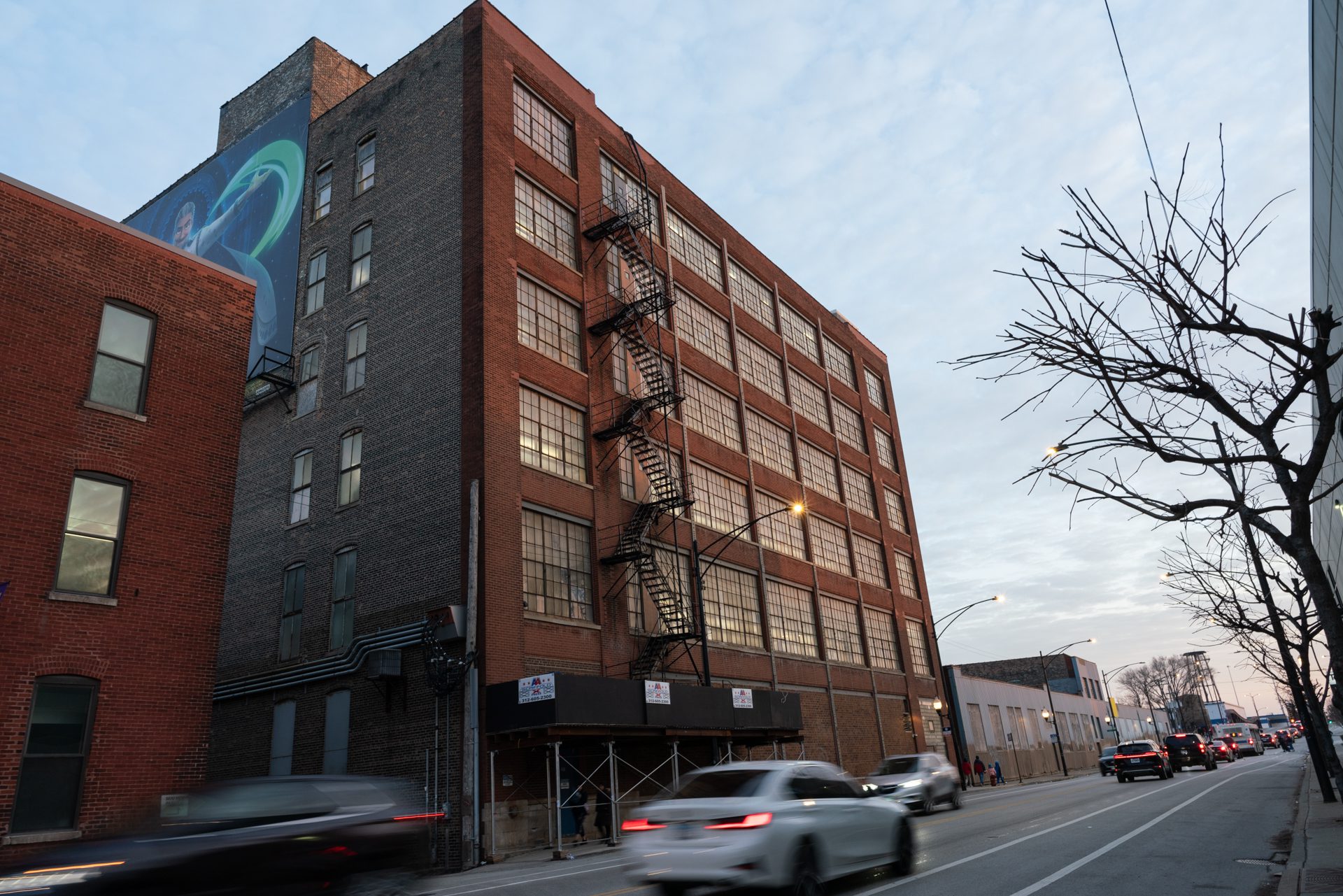
The last Department of Buildings inspection on record for the adjoining one-story building at 2301 S. Halsted Street occurred in 2016.
City officials hosted a last-minute meeting in October to announce plans for the temporary Pilsen shelter. In a statement, Pilsen Alderman Byron Sigcho-Lopez wrote as the Chairman of the Housing and Real Estate Committee, “it was my duty to address the housing crisis with actionable solutions and in collaboration with city departments, community stakeholders and sister agencies.”
In 2023, the city spent tens of millions of dollars on shelters for migrants. Among the items, the city says they provide shelter residents with a cot, blanket, pillow, three meals per day, access to showers, hygiene items, and access to laundry services.
During the meeting, Sigcho-Lopez and officials from the Department of Family Support Services, Office of Emergency Management and Communications and Chicago Police told neighbors the former warehouse would hold up to 1,000 migrants. But just two months later, that number has more than doubled, according to internal city records.
Life Inside One Shelter
Inside the Pilsen shelter, dozens of cots, inches apart, are grouped together by zones in various areas of the one-story building, according to videos shown to Borderless. Staff have barred migrants from recording or taking photos inside the shelter and “threatened” to kick migrants out if they speak with members of the media.
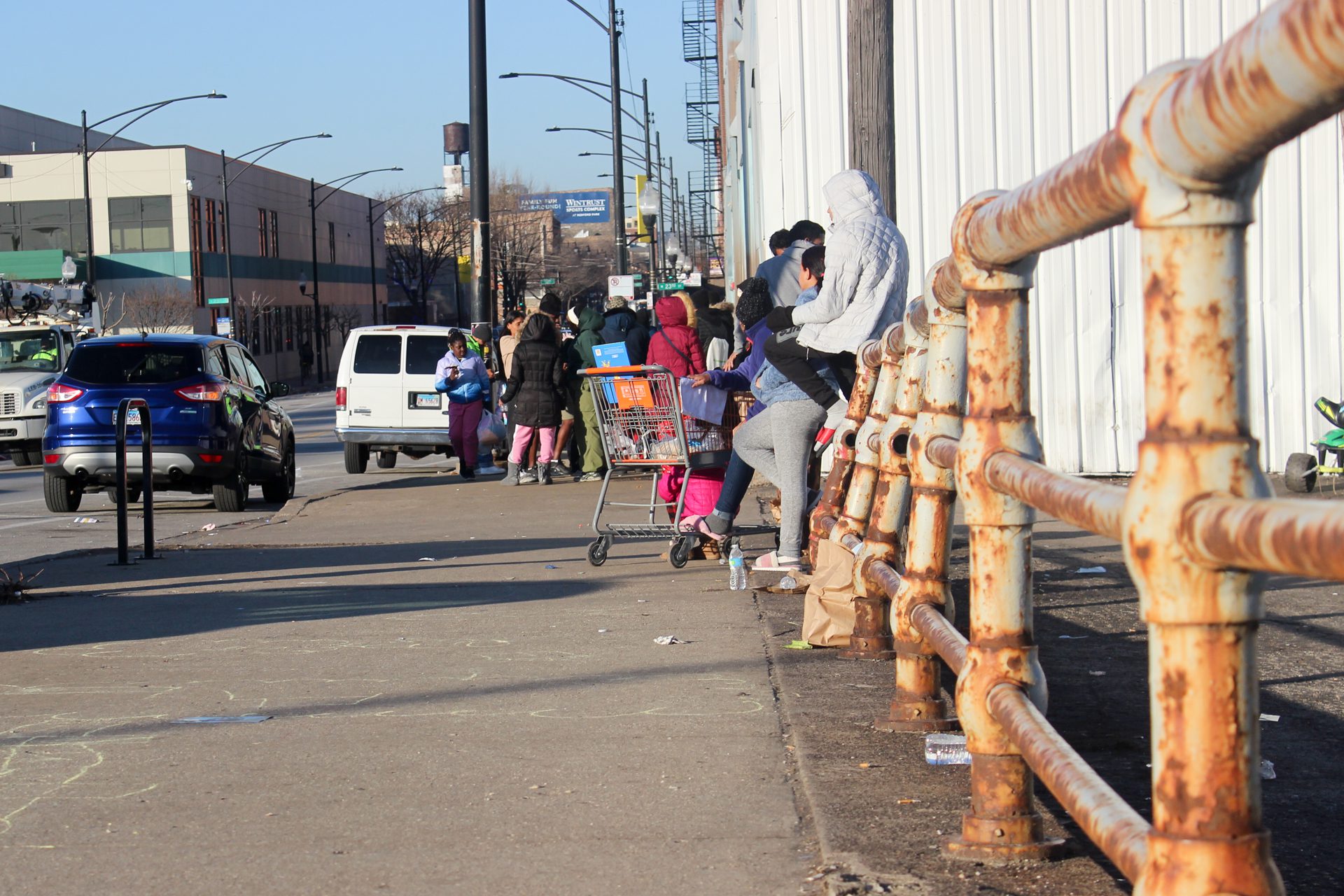
Venezuelan migrants described the sleeping areas as crammed with little space to move around and no privacy for the hundreds assigned to the one-story sleeping quarters. The shelter allows for items to be kept on or under the cots but prohibits food from being stored, migrants said. One video appeared to show shelter workers inspecting cots and throwing away items they found.
Many of the migrants sleeping in the warehouse’s Zone A and B described frigid temperatures and “fiber” particles falling from the ceiling. Some parents with children at the shelter told Borderless their children were suffering from eye infections they believed to be caused by the falling debris.
“All my kids had eye infections because the ceiling is shedding fibers,” Maria said.
Along with concerns about the safety of the building, migrants said shelter meals were sometimes spoiled. They said the shelter serves the same meals every day – chicken and rice – and the food is often too spicy for both children and adults. Several migrants also said shelter workers often rationed water, distributing only half a cup during meals.
In one video reviewed by Borderless, a staffer is seen turning away shelter residents until designated meal times as they partially fill styrofoam cups. “Sometimes they restrict the drinking water,” one migrant said.
In another video, residents line the wall of the warehouse, snaking around some of the beds set up in the middle of the floor, waiting for food. “There is such a long line to get food,” one woman told Borderless. “You have to stand for two to three hours to get food. It’s ridiculous.”
In recent weeks, many migrants have grown concerned about the spread of chickenpox, respiratory illness and the flu, especially as the populations have surged. A pop-up clinic comes in for a few hours every eight days to provide medical help, the migrants say, but little is done during those quick visits for those seeking medical attention. Migrants described waiting a long time to be seen only for no treatment to be given.
“A lot of people have gotten sick,” Maria said. A woman had to have surgery because she got a parasite in the pancreas or the liver…Her husband said he was going to sue them.”
“All my kids had eye infections because the ceiling is shedding fibers.”
A frustrated mother whose two children recently fell ill was not given any medicine and was told to go to a clinic outside the shelter if she needed additional support.
A recent arrival at the shelter was hoping to get antibiotics to help him recover from a throat infection and the flu, but the clinic staff didn’t provide any medication. Sitting in the sun in front of the shelter, he was frustrated he wasn’t given antibiotics, nor could he afford any after being robbed in Mexico on his way to the United States.
“There is no medicine,” his wife said, describing their frustration. “For those who aren’t working, we are out on the street asking for help to buy medicine. At the moment, my husband is sick. He has a throat infection [and the flu]. They checked him out, but they didn’t give him anything. No antibiotics. No pain reliever.”
Arduous Work Permit Restrictions Make Shelter Stays Longer
Many migrants envisioned their shelter stays would be short, but they’ve struggled to land work that would help them find more permanent housing.
In September, President Joe Biden extended Temporary Protection Status for Venezuelan migrants who arrived before July 31, a status that would allow them to get a work permit. The application process is complicated and too expensive for many, however. Those who arrived after July are ineligible for TPS and must seek out other options, such as applying for asylum, to receive a work permit.
Many migrants are reaching out to their networks, hoping to find a job that would allow them to leave behind the conditions at the shelter. It’s been a struggle, but they are craving privacy and safety for their families.
“I want to work,” one man told Borderless. “I came here to work.”
Read More of Our Coverage
Some have noted that other migrants have landed jobs under the table, but those are scarce. Others have lost hope and are reaching out to families in other parts of the U.S., hoping to join them in warmer climates and escape the crowded shelters.
While families sat along Halsted just north of the Chicago River — a few hundred feet from the shelter’s entrance — one migrant woman told Borderless she was deflated by life in the shelter, a lack of work, and a serious illness that has sidetracked her.
In the few months at the shelter, she’s grown desperate, longing for the privacy of her home.
“Sometimes, I regret coming here,” she said through tears.
She’s asked shelter staff for help accessing resources, but staffers have responded harshly, she said.
Many of the migrants who spoke with Borderless said they’ve opted to keep quiet and not speak up about the conditions. They fear being kicked out into the cold, or worse, being written up and having that held against them in immigration court.
“They’re constantly threatening you,” Maria said. “You have to be so careful because they write a report for everything. If you slip, they report you and kick you out. It’s a bit frustrating.”
“They treat us terribly — like dogs,” another young woman said.
Outside the shelter on a recent Thursday night, a young mother who arrived at the shelter about three weeks ago leaned on her child’s stroller reflecting on the shelter conditions inside. While it isn’t great, she didn’t have many options. Her family has been trying to find work cleaning houses or other manual labor so they can get out of the shelter quickly.
In the meantime, while they wait, “it’s better to keep quiet,” she said.
Maria* used a pseudonym for fear of retaliation from shelter staff.
Support for this investigation came from the Fund For Investigative Journalism.

Bring power to immigrant voices!
Our work is made possible thanks to donations from people like you. Support high-quality reporting by making a tax-deductible donation today.

